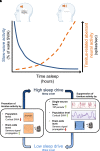Tinnitus: at a crossroad between phantom perception and sleep
- PMID: 35620170
- PMCID: PMC9128384
- DOI: 10.1093/braincomms/fcac089
Tinnitus: at a crossroad between phantom perception and sleep
Abstract
Sensory disconnection from the environment is a hallmark of sleep and is crucial for sleep maintenance. It remains unclear, however, whether internally generated percepts-phantom percepts-may overcome such disconnection and, in turn, how sleep and its effect on sensory processing and brain plasticity may affect the function of the specific neural networks underlying such phenomena. A major hurdle in addressing this relationship is the methodological difficulty to study sensory phantoms, due to their subjective nature and lack of control over the parameters or neural activity underlying that percept. Here, we explore the most prevalent phantom percept, subjective tinnitus-or tinnitus for short-as a model to investigate this. Tinnitus is the permanent perception of a sound with no identifiable corresponding acoustic source. This review offers a novel perspective on the functional interaction between brain activity across the sleep-wake cycle and tinnitus. We discuss characteristic features of brain activity during tinnitus in the awake and the sleeping brain and explore its effect on sleep functions and homeostasis. We ask whether local changes in cortical activity in tinnitus may overcome sensory disconnection and prevent the occurrence of global restorative sleep and, in turn, how accumulating sleep pressure may temporarily alleviate the persistence of a phantom sound. Beyond an acute interaction between sleep and neural activity, we discuss how the effects of sleep on brain plasticity may contribute to aberrant neural circuit activity and promote tinnitus consolidation. Tinnitus represents a unique window into understanding the role of sleep in sensory processing. Clarification of the underlying relationship may offer novel insights into therapeutic interventions in tinnitus management.
Keywords: neural plasticity; phantom percepts; sleep; spontaneous brain activity; tinnitus.
© The Author(s) 2022. Published by Oxford University Press on behalf of the Guarantors of Brain.
Figures




Similar articles
-
Phantom percepts: tinnitus and pain as persisting aversive memory networks.Proc Natl Acad Sci U S A. 2011 May 17;108(20):8075-80. doi: 10.1073/pnas.1018466108. Epub 2011 Apr 18. Proc Natl Acad Sci U S A. 2011. PMID: 21502503 Free PMC article.
-
Directing neural plasticity to understand and treat tinnitus.Hear Res. 2013 Jan;295:58-66. doi: 10.1016/j.heares.2012.10.001. Epub 2012 Oct 23. Hear Res. 2013. PMID: 23099209 Review.
-
Illusory percepts from auditory adaptation.J Acoust Soc Am. 2007 Mar;121(3):1632-41. doi: 10.1121/1.2431346. J Acoust Soc Am. 2007. PMID: 17407900
-
Deep brain stimulation in area LC controllably triggers auditory phantom percepts.Neurosurgery. 2012 Feb;70(2):398-405; discussion 405-6. doi: 10.1227/NEU.0b013e3182320ab5. Neurosurgery. 2012. PMID: 21849922
-
Tinnitus-related neural activity: theories of generation, propagation, and centralization.Hear Res. 2013 Jan;295:161-71. doi: 10.1016/j.heares.2012.09.010. Epub 2012 Oct 23. Hear Res. 2013. PMID: 23088832 Review.
Cited by
-
Consecutive Dual-Session Transcranial Direct Current Stimulation in Chronic Subjective Severe to Catastrophic Tinnitus with Normal Hearing.J Pers Med. 2024 May 28;14(6):577. doi: 10.3390/jpm14060577. J Pers Med. 2024. PMID: 38929798 Free PMC article.
-
Effects of otolaryngological diseases on sleep quality, anxiety, and depression: a multicenter observational study.BMC Psychiatry. 2025 Feb 13;25(1):124. doi: 10.1186/s12888-025-06531-x. BMC Psychiatry. 2025. PMID: 39948523 Free PMC article.
-
Association between obstructive sleep apnea and Tinnitus in the United States: NHANES 2005-2020.Sleep Breath. 2025 Jan 22;29(1):86. doi: 10.1007/s11325-025-03243-0. Sleep Breath. 2025. PMID: 39841314
-
Glymphatic system dysfunction in chronic tinnitus patients with sleep disturbance.Front Neurol. 2025 Jun 10;16:1504645. doi: 10.3389/fneur.2025.1504645. eCollection 2025. Front Neurol. 2025. PMID: 40556648 Free PMC article.
-
Using ALE coordinate-based meta-analysis to observe resting-state brain abnormalities in subjective tinnitus.Brain Imaging Behav. 2024 Jun;18(3):496-509. doi: 10.1007/s11682-023-00846-7. Epub 2024 Jan 3. Brain Imaging Behav. 2024. PMID: 38170303
References
-
- Bazil CW. Seizure modulation by sleep and sleep state. Brain Res. 2019;1703:13–17. - PubMed
-
- Frauscher B, Gotman J. Sleep, oscillations, interictal discharges, and seizures in human focal epilepsy. Neurobiol Dis. 2019;127:545–553. - PubMed
-
- McCormack A, Edmondson-Jones M, Somerset S, Hall D. A systematic review of the reporting of tinnitus prevalence and severity. Hear Res. 2016;337:70–79. - PubMed
-
- Baguley D, McFerran D, Hall D. Tinnitus. Lancet Lond Engl. 2013;382(9904):1600–1607. - PubMed
Publication types
LinkOut - more resources
Full Text Sources
